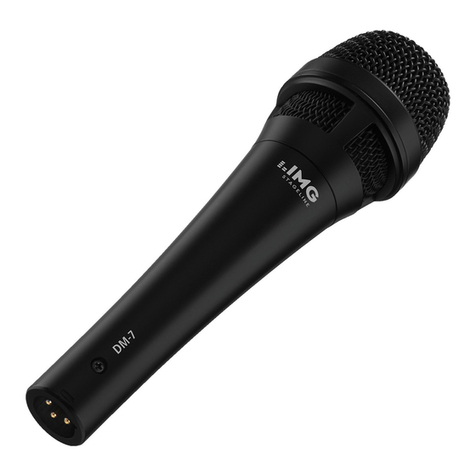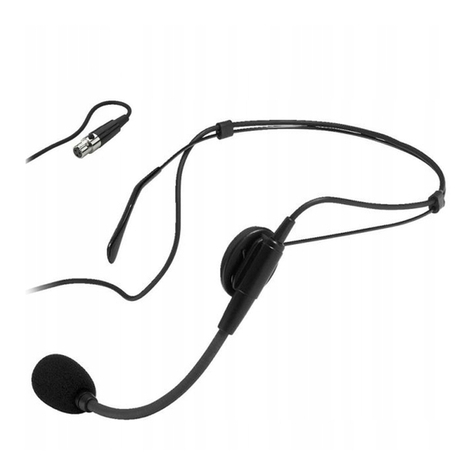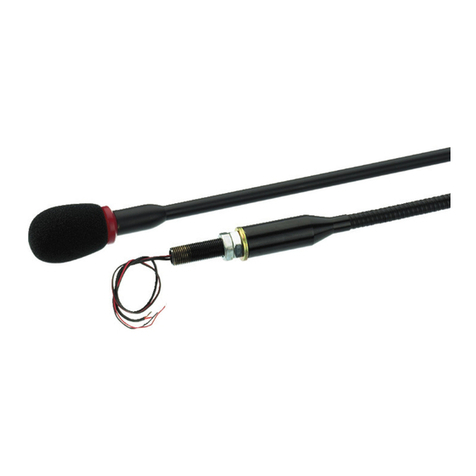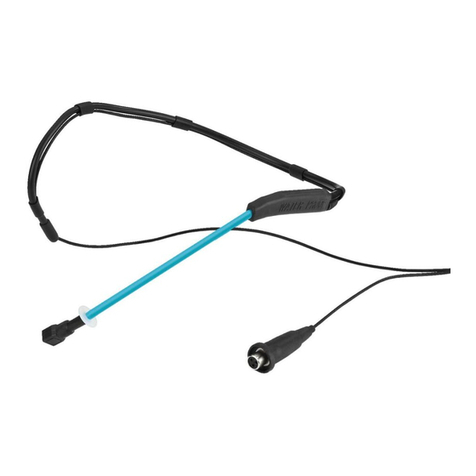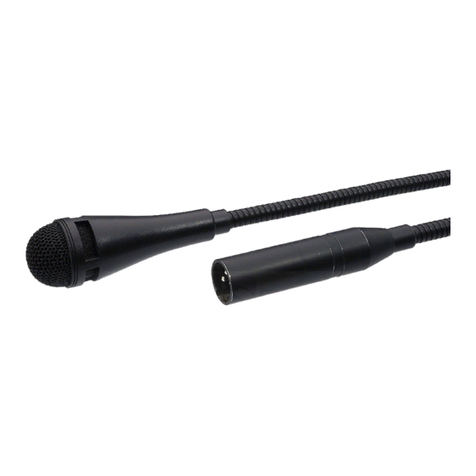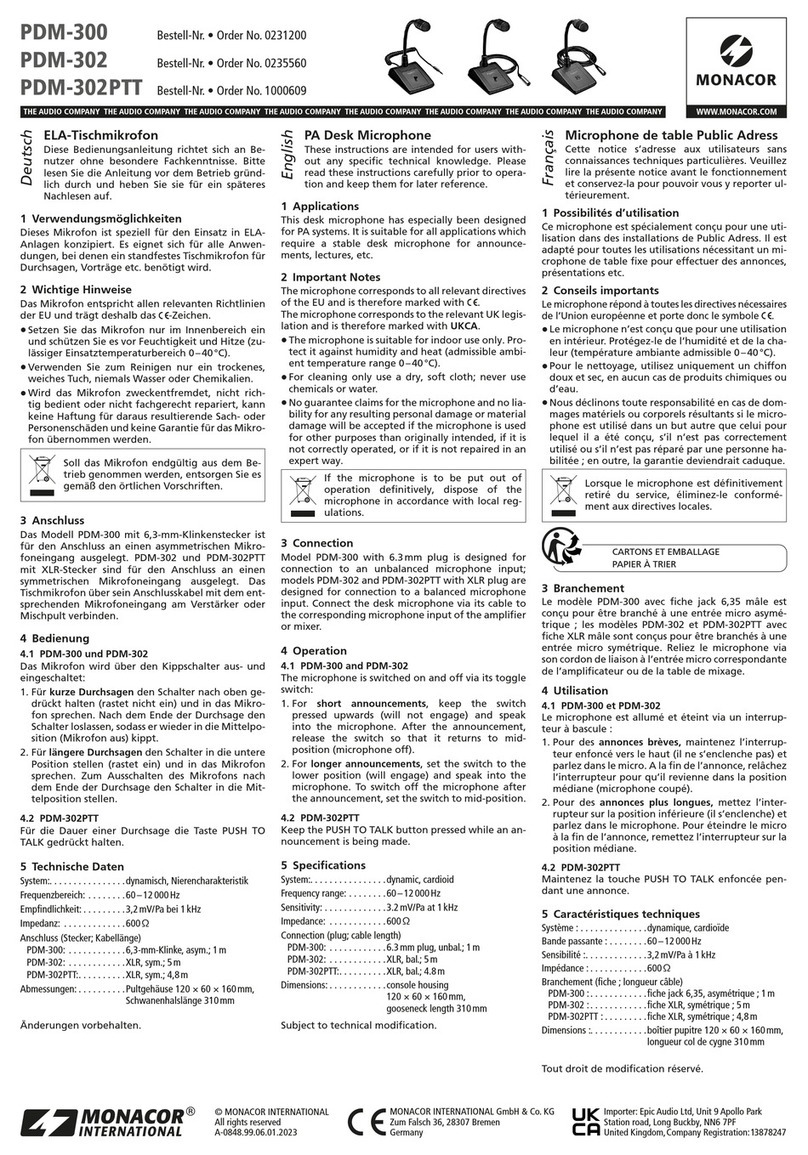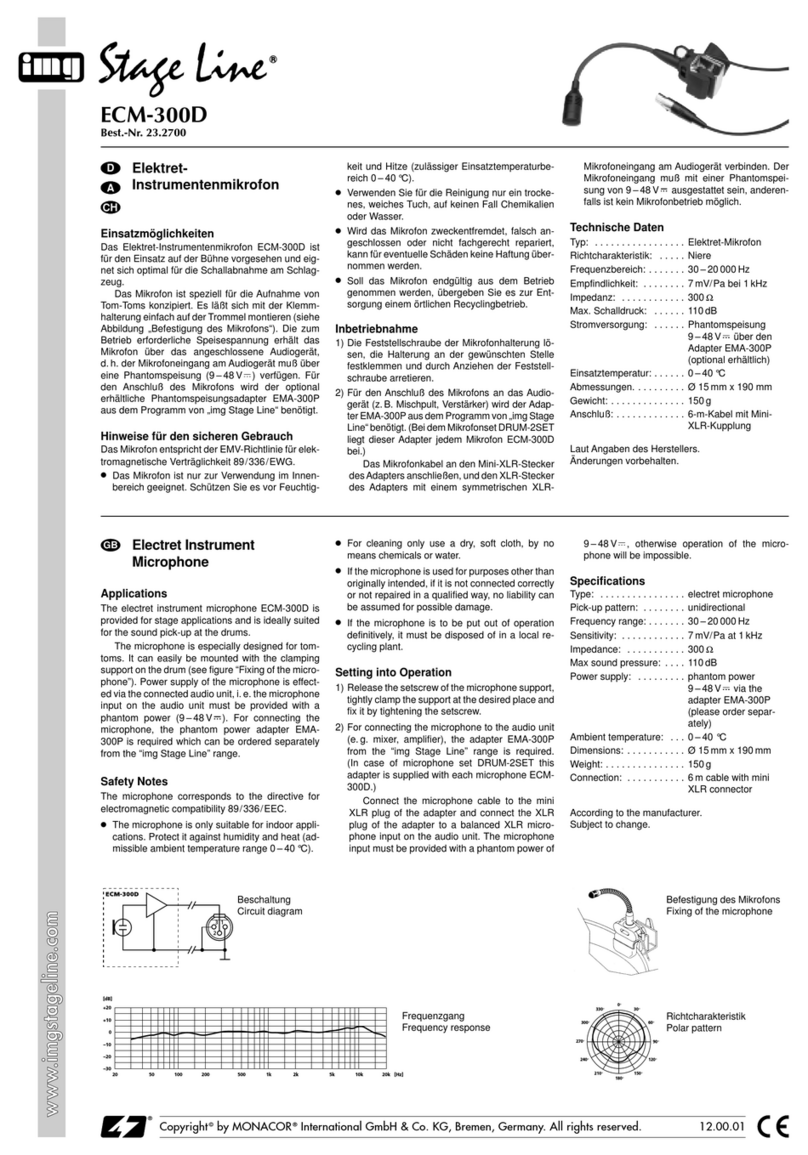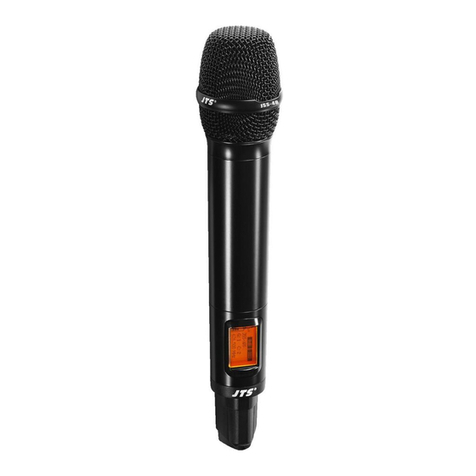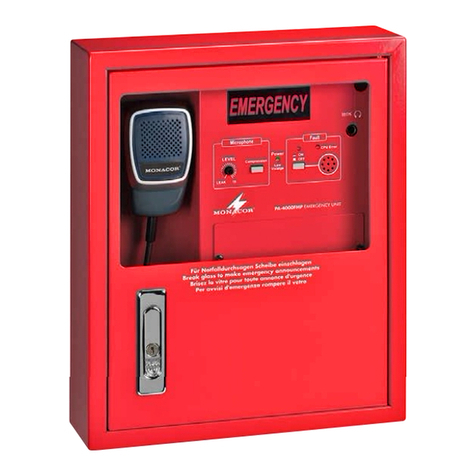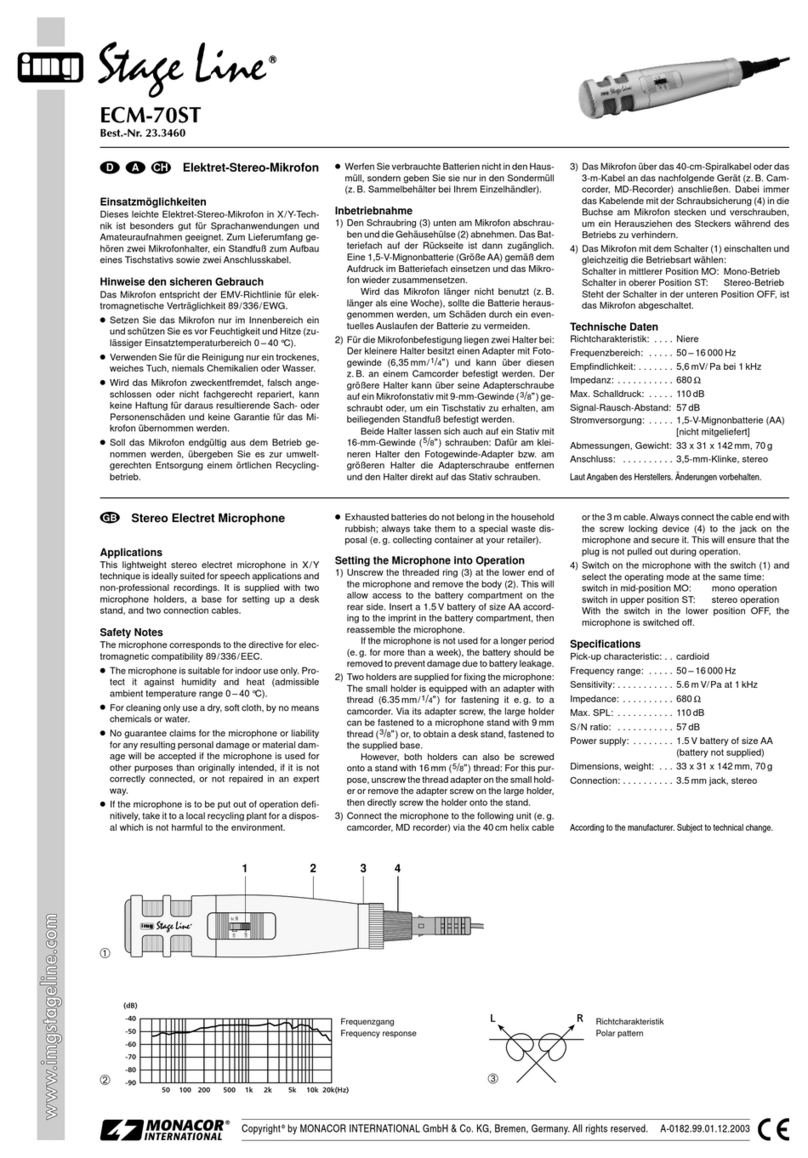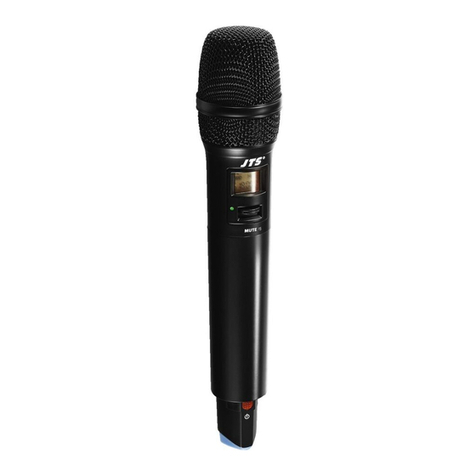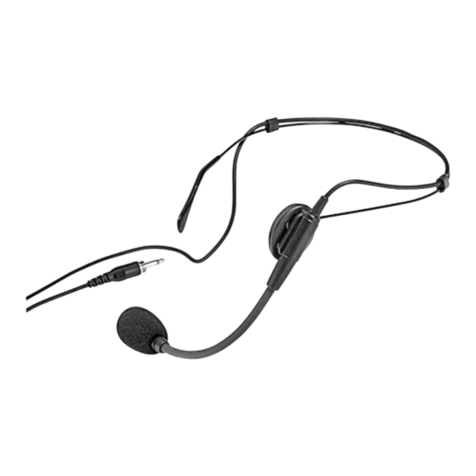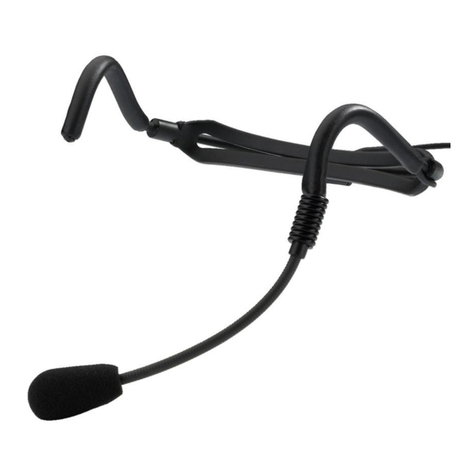Microphone électret
pour instruments
Veuillez lire la présente notice avec attention avant
le fonctionnement et conservez-la pour pouvoir
vous y reporter ultérieurement.
1 Possibilités dʼutilisation
Le microphone électret pour instruments ECM-
310W est spécialement conçu pour une utilisation
sur scène et est idéal pour la prise de son dʼinstru-
ments à vent. Grâce à la fixation par pince, il peut
être facilement placé sur le cône de sortie dʼair de
lʼinstrument.
Le microphone est alimenté via lʼappareil audio
relié : lʼentrée micro sur lʼappareil audio doit dispo-
ser dʼune alimentation fantôme (9 – 48 V ). Un
adaptateur dʼalimentation fantôme pour le branche-
ment est livré avec le micro. Sont également livrés
un coffret de transport plastique et une bonnette de
protection anti-vent.
2 Conseils dʼutilisation et de sécurité
Le microphone répond à toutes les directives
nécessaires de lʼUnion Européenne et porte donc le
symbole .
GLe microphone nʼest conçu que pour une utilisa-
tion en intérieur ; protégez-le de lʼhumidité et de
la chaleur (plage de température de fonctionne-
ment autorisée 0 – 40 °C).
GPour le nettoyer, utilisez un chiffon sec et doux,
en aucun cas de produits chimiques ou dʼeau.
GNous déclinons toute responsabilité en cas de
dommages matériels ou corporels si le micro est
utilisé dans un but autre que celui pour lequel il a
été conçu, sʼil nʼest pas correctement branché ou
sʼil nʼest pas réparé par une personne habilitée ;
en outre, la garantie deviendrait caduque.
3 Montage
Fixez le support micro sur lʼinstrument, dirigez le col
de cygne du micro de manière optimale. Si besoin,
placez la bonnette de protection anti-vent livrée.
4 Branchement
Reliez le cordon micro à la mini fiche XLR mâle de
lʼadaptateur dʼalimentation livré et reliez la fiche
XLR mâle de lʼadaptateur à une entrée micro XLR
Lorsque le micro est définitivement retiré du
circuit de distribution, vous devez le déposer
dans une usine de recyclage adaptée pour
contribuer à son élimination non polluante.
symétrique sur lʼappareil audio. Lʼentrée micro doit
être dotée dʼune alimentation fantôme 9 – 48 V
sinon le micro ne fonctionne pas.
5 Caractéristiques techniques
Type : . . . . . . . . . . . . . . . supercardioïde
Bande passante : . . . . . . 30 – 17 000 Hz
Sensibilité : . . . . . . . . . . . 4,5 mV/Pa à 1 kHz
Impédance : . . . . . . . . . . 200 Ω
Pression sonore max. : . . 120 dB
Température
de fonctionnement : . . . . 0 – 40 °C
Alimentation : . . . . . . . . . alimentation fantôme
9 – 48 V
Longueur micro : . . . . . . 140 mm
Poids : . . . . . . . . . . . . . . 150 g
Branchement
Micro : . . . . . . . . . . . . mini XLR, asymétrique
Adaptateur
alimentation : . . . . . . . mini XLR, asymétrique/
XLR, symétrique
Tout droit de modification réservé.
Microfono allʼelettrete
per strumenti musicali
Vi preghiamo di leggere attentamente le presenti
istruzioni prima dellʼuso e di conservarle per un uso
futuro.
1 Possibilità dʼimpiego
Il microfono ECM-310W per strumenti musicali è
previsto per lʼimpiego professionale ed è particolar-
mente adatto per la riproduzione di strumenti a fiato.
Con il morsetto può essere fissato comodamente
sul padiglione dello strumento.
Il microfono viene alimentato attraverso lʼappa-
recchio audio collegato; ciò significa che lʼingresso
microfono dellʼapparecchio audio devʼessere equi-
paggiato con alimentazione phantom (9 – 48 V ).
Per il collegamento, un adattatore di alimentazione
phantom si trova in dotazione, come anche una
custodia di plastica e una spugna antivento.
2 Avvertenze di sicurezza
Il microfono è conforme a tutte le direttive rilevanti
dellʼUE e pertanto porta la sigla .
GLo strumento è previsto solo per lʼuso allʼinterno
di locali. Proteggerlo dallʼumidità e dal calore
(temperatura dʼimpiego ammessa fra 0 e 40 °C).
GPer la pulizia usare solo un panno morbido,
asciutto; non impiegare in nessun caso prodotti
chimici o acqua.
GNel caso dʼuso improprio, di collegamenti sba-
gliati o di riparazione scorretta non si assume
nessuna responsabilità per eventuali danni con-
sequenziale a persone o a cose e cessa ogni
diritto di garanzia per il microfono.
3 Montaggio
Fissare il supporto sullo strumento ed orientare il
collo di cigno del microfono in modo ottimale. Se è
necessario montare la spugna antivento, in dota-
zione.
4 Collegamento
Collegare il cavo del microfono con la presa mini-
XLR dellʼadattatore di alimentazione in dotazione e
collegare la presa XLR dellʼadattatore con un in-
Se si desidera eliminare il microfono defi-
nitivamente, consegnarlo per lo smalti-
mento ad unʼistituzione locale per il rici-
claggio.
gresso microfono XLR simmetrico sullʼapparecchio
audio. Lʼingresso microfono deve essere equipag-
giato con unʼalimentazione phantom 9 – 48 V ,
altrimenti il microfono non può funzionare.
5 Dati tecnici
Sistema: . . . . . . . . . . . . . super cardioide
Banda passante: . . . . . . 30 – 17 000 Hz
Sensibilità: . . . . . . . . . . . 4,5 mV/Pa a 1 kHz
Impedenza: . . . . . . . . . . . 200 Ω
Pressione sonora max.: . 120 dB
Temperatura dʼimpiego: . 0 – 40 °C
Alimentazione: . . . . . . . . alimentazione phantom
9 – 48 V
Lunghezza microfono: . . 140 mm
Peso: . . . . . . . . . . . . . . . 150 g
Collegamento
Microfono: . . . . . . . . . mini-XLR, asimm.
Adattatore:
alimentatore: . . . . . . . mini-XLR, asimm./
XLR, simm.
Con riserva di modifiche tecniche.
ECM-310W
Best.-Nr. 23.3360
www.imgstageline.com
Réponse en fréquence
Risposta di frequenza
Caractéristique
Caratteristica direzionale
I
F B CH
®
MONACOR INTERNATIONAL GmbH & Co. KG
•
Zum Falsch 36
•
28307 Bremen
•
Germany
Copyright
©
by MONACOR INTERNATIONAL. All rights reserved. A-0129.99.02.07.2011
